
Crow-stepped gable
Encyclopedia

Gable
A gable is the generally triangular portion of a wall between the edges of a sloping roof. The shape of the gable and how it is detailed depends on the structural system being used and aesthetic concerns. Thus the type of roof enclosing the volume dictates the shape of the gable...
-end of a building. The top of the parapet wall
Parapet
A parapet is a wall-like barrier at the edge of a roof, terrace, balcony or other structure. Where extending above a roof, it may simply be the portion of an exterior wall that continues above the line of the roof surface, or may be a continuation of a vertical feature beneath the roof such as a...
projects above the roofline and the top of the brick or stone wall is stacked in a step pattern above the roof as a decoration and as a convenient way to finish the brick courses.
Early examples, from the 15th century onwards, are found in England
England
England is a country that is part of the United Kingdom. It shares land borders with Scotland to the north and Wales to the west; the Irish Sea is to the north west, the Celtic Sea to the south west, with the North Sea to the east and the English Channel to the south separating it from continental...
, Denmark
Denmark
Denmark is a Scandinavian country in Northern Europe. The countries of Denmark and Greenland, as well as the Faroe Islands, constitute the Kingdom of Denmark . It is the southernmost of the Nordic countries, southwest of Sweden and south of Norway, and bordered to the south by Germany. Denmark...
, Germany
Germany
Germany , officially the Federal Republic of Germany , is a federal parliamentary republic in Europe. The country consists of 16 states while the capital and largest city is Berlin. Germany covers an area of 357,021 km2 and has a largely temperate seasonal climate...
, Switzerland
Switzerland
Switzerland name of one of the Swiss cantons. ; ; ; or ), in its full name the Swiss Confederation , is a federal republic consisting of 26 cantons, with Bern as the seat of the federal authorities. The country is situated in Western Europe,Or Central Europe depending on the definition....
, and Sweden
Sweden
Sweden , officially the Kingdom of Sweden , is a Nordic country on the Scandinavian Peninsula in Northern Europe. Sweden borders with Norway and Finland and is connected to Denmark by a bridge-tunnel across the Öresund....
. Crow-stepped gables were also used in Scotland
Scotland
Scotland is a country that is part of the United Kingdom. Occupying the northern third of the island of Great Britain, it shares a border with England to the south and is bounded by the North Sea to the east, the Atlantic Ocean to the north and west, and the North Channel and Irish Sea to the...
as early as the 16th century. Examples of Scottish crow-stepped gable can be seen at Muchalls Castle
Muchalls Castle
Muchalls Castle stands overlooking the North Sea in the countryside of Kincardine and Mearns, Aberdeenshire, Scotland. The lower course is a well preserved double groined 13th century towerhouse structure, built by the Frasers of Muchalls. Upon this structure, the 17th century castle was begun by...
, Monboddo House
Monboddo House
Monboddo House is a historically famous mansion in The Mearns, Scotland. The structure was generally associated with the Burnett of Leys family. The property itself was owned by the Barclay family from the 13th century, at which time a tower house structure was erected...
and the Stonehaven Tolbooth
Stonehaven Tolbooth
The Stonehaven Tolbooth is a late 16th century stone building originally used as a courthouse and a prison in the town of Stonehaven, Aberdeenshire, Scotland...
, all late 16th and early 17th century buildings. Crow-stepped gables are also common on Danish medieval churches.
In the Dutch language, this design is termed trapgevel or "stair-step gable", characteristic of many brick buildings in the Netherlands
Netherlands
The Netherlands is a constituent country of the Kingdom of the Netherlands, located mainly in North-West Europe and with several islands in the Caribbean. Mainland Netherlands borders the North Sea to the north and west, Belgium to the south, and Germany to the east, and shares maritime borders...
, Belgium
Belgium
Belgium , officially the Kingdom of Belgium, is a federal state in Western Europe. It is a founding member of the European Union and hosts the EU's headquarters, and those of several other major international organisations such as NATO.Belgium is also a member of, or affiliated to, many...
and in Dutch colonial settlements. 19th century examples are found in North America
North America
North America is a continent wholly within the Northern Hemisphere and almost wholly within the Western Hemisphere. It is also considered a northern subcontinent of the Americas...
, and the step gable is also a feature of the northern-renaissance revival styles.
Construction
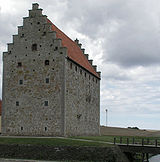
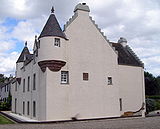
Chimney sweep
A chimney sweep is a worker who clears ash and soot from chimneys. The chimney uses the pressure difference caused by a hot column of gas to create a draught and draw air over the hot coals or wood enabling continued combustion. Chimneys may be straight or contain many changes of direction. During...
s and roofers in earlier times, where cranes were non-existent and tall ladders were not common.
With crow steps, the roofing slate
Slate
Slate is a fine-grained, foliated, homogeneous metamorphic rock derived from an original shale-type sedimentary rock composed of clay or volcanic ash through low-grade regional metamorphism. The result is a foliated rock in which the foliation may not correspond to the original sedimentary layering...
s (rarely tiles) do not reach the end of the building, so making for a special problem with keeping the roof watertight. Many different schemes are found for overcoming this, some of which are described below. Terms currently used in Scotland are italicised.
- Slates may be laid to the edge of the crow step, with the last slate raised by a wedge (tilting fillet). Then mortarMortar (masonry)Mortar is a workable paste used to bind construction blocks together and fill the gaps between them. The blocks may be stone, brick, cinder blocks, etc. Mortar becomes hard when it sets, resulting in a rigid aggregate structure. Modern mortars are typically made from a mixture of sand, a binder...
(lime mortar or cementCementIn the most general sense of the word, a cement is a binder, a substance that sets and hardens independently, and can bind other materials together. The word "cement" traces to the Romans, who used the term opus caementicium to describe masonry resembling modern concrete that was made from crushed...
) would be laid over the edge of the slate to seal the gap. Other solutions involve working with leadLeadLead is a main-group element in the carbon group with the symbol Pb and atomic number 82. Lead is a soft, malleable poor metal. It is also counted as one of the heavy metals. Metallic lead has a bluish-white color after being freshly cut, but it soon tarnishes to a dull grayish color when exposed...
.
- A groove approximately 25 mm (1 inch) deep is cut into the inside edge of the steps. A lead abutment flashing is inserted into this groove, called a chase or a raggle. The lead is laid over the end slate, which is raised by a tilting fillet.
- LeadLeadLead is a main-group element in the carbon group with the symbol Pb and atomic number 82. Lead is a soft, malleable poor metal. It is also counted as one of the heavy metals. Metallic lead has a bluish-white color after being freshly cut, but it soon tarnishes to a dull grayish color when exposed...
ing is inserted into a raggle, and used to make a trough, or secret gutter, running down the inside edge of the steps. The far edge of the trough is raised over a triangular fillet. Slates are then laid resting on that trough edge and overlapping into the trough, which is open and runs directly down to gutters (roans).
- Rather than forming a raggle, lead flashingFlashingFlashing may refer to:*Exhibitionism, briefly exposing one's body in a usually sexual way, acceptable or not depending on context*Flashing , construction material used to prevent the passage of water around objects...
s may be placed into the joints between bricks as they are laid.
When lead is to be held into a raggle, small folded lead wedges called bats are inserted at intervals and hammered in so they expand. The raggle is then sealed with mortar
Mortar (masonry)
Mortar is a workable paste used to bind construction blocks together and fill the gaps between them. The blocks may be stone, brick, cinder blocks, etc. Mortar becomes hard when it sets, resulting in a rigid aggregate structure. Modern mortars are typically made from a mixture of sand, a binder...
.
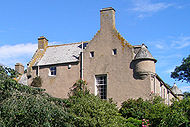
Sandstone
Sandstone is a sedimentary rock composed mainly of sand-sized minerals or rock grains.Most sandstone is composed of quartz and/or feldspar because these are the most common minerals in the Earth's crust. Like sand, sandstone may be any colour, but the most common colours are tan, brown, yellow,...
, even on buildings otherwise of granite
Granite
Granite is a common and widely occurring type of intrusive, felsic, igneous rock. Granite usually has a medium- to coarse-grained texture. Occasionally some individual crystals are larger than the groundmass, in which case the texture is known as porphyritic. A granitic rock with a porphyritic...
, and it is said that the porous nature of sandstone leads to problems with water penetration. Because of this, crow steps are sometimes capped with lead or sealed with other materials.
Design variation
There are a number of variations on the basic design. One such structure is Culross PalaceCulross Palace
Culross Palace is a late 16th - early 17th century merchant's house in Culross, Fife, Scotland.The palace, or "Great Lodging", was constructed between 1597 and 1611 by Sir George Bruce, the Laird of Carnock. Bruce was a successful merchant who had a flourishing trade with other Forth ports, the Low...
built in 1597 which features a veil
Veil
A veil is an article of clothing, worn almost exclusively by women, that is intended to cover some part of the head or face.One view is that as a religious item, it is intended to show honor to an object or space...
ed woman on the crow steps. Roofs in Scotland are typically steeper than in the rest of the United Kingdom (possibly because it snows more) making for steeper and more step-like steps.
Worldwide examples
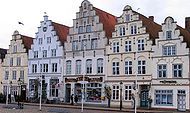
- Baunachshof, Wertheim am MainWertheim am MainWertheim is a town in southwestern Germany, in the state of Baden-Württemberg with a population of 24,202. It is located on the confluence of the rivers Tauber and Main.It is known for its wine, castle and medieval town centre.-Geography:...
, GermanyGermanyGermany , officially the Federal Republic of Germany , is a federal parliamentary republic in Europe. The country consists of 16 states while the capital and largest city is Berlin. Germany covers an area of 357,021 km2 and has a largely temperate seasonal climate... - Fetteresso CastleFetteresso CastleFetteresso Castle is a 14th century towerhouse, rebuilt in 1761 as a Scottish gothic style Palladian manor, with clear evidence of prehistoric use of the site. It is situated immediately west of the town of Stonehaven in Kincardineshire slightly to the west of the A90 dual carriageway...
, ScotlandScotlandScotland is a country that is part of the United Kingdom. Occupying the northern third of the island of Great Britain, it shares a border with England to the south and is bounded by the North Sea to the east, the Atlantic Ocean to the north and west, and the North Channel and Irish Sea to the... - Forse House, Latherton
- Kapetanovo CastleKapetanovo CastleKapetanovo Castle is a neogothic castle located in the village of Stari Lec, in the Plandište municipality in northeastern Serbia. In 1991, it was included on the national list of monuments of culture of great importance, and since then it has been protected....
, SerbiaSerbiaSerbia , officially the Republic of Serbia , is a landlocked country located at the crossroads of Central and Southeast Europe, covering the southern part of the Carpathian basin and the central part of the Balkans... - Maybole Castle
- Saint Andrews Tower, TorontoTorontoToronto is the provincial capital of Ontario and the largest city in Canada. It is located in Southern Ontario on the northwestern shore of Lake Ontario. A relatively modern city, Toronto's history dates back to the late-18th century, when its land was first purchased by the British monarchy from...
, CanadaCanadaCanada is a North American country consisting of ten provinces and three territories. Located in the northern part of the continent, it extends from the Atlantic Ocean in the east to the Pacific Ocean in the west, and northward into the Arctic Ocean... - The Castle, Billings, MontanaBillings, MontanaBillings is the largest city in the U.S. state of Montana, and is the principal city of the Billings Metropolitan Area, the largest metropolitan area in over...
, USA - Torwood CastleTorwood CastleTorwood Castle is a castle ruin near the village of Torwood, in the Falkirk Council area of central Scotland.It has been estimated as being built around 1566 for Sir Alexander Forrester. It was once the seat of Clan Forrester. The castle was built by the Lords Forrester, who supplied the Crown with...
, StirlingshireStirlingshireStirlingshire or the County of Stirling is a registration county of Scotland, based around Stirling, the former county town. It borders Perthshire to the north, Clackmannanshire and West Lothian to the east, Lanarkshire to the south, and Dunbartonshire to the south-west.Until 1975 it was a county...
, ScotlandScotlandScotland is a country that is part of the United Kingdom. Occupying the northern third of the island of Great Britain, it shares a border with England to the south and is bounded by the North Sea to the east, the Atlantic Ocean to the north and west, and the North Channel and Irish Sea to the... - Wickham Court, BromleyBromleyBromley is a large suburban town in south east London, England and the administrative headquarters of the London Borough of Bromley. It was historically a market town, and prior to 1963 was in the county of Kent and formed the administrative centre of the Municipal Borough of Bromley...
, EnglandEnglandEngland is a country that is part of the United Kingdom. It shares land borders with Scotland to the north and Wales to the west; the Irish Sea is to the north west, the Celtic Sea to the south west, with the North Sea to the east and the English Channel to the south separating it from continental... - 11 Dyke Road, Brighton11 Dyke Road, BrightonThe building at 11 Dyke Road in Brighton, part of the English city of Brighton and Hove, is now a nightclub operating under the name "New Hero", but was originally the Swan Downer School for poor girls, for whom it was designed and built in 1867 by prolific architect George Somers Leigh Clarke...
, EnglandEnglandEngland is a country that is part of the United Kingdom. It shares land borders with Scotland to the north and Wales to the west; the Irish Sea is to the north west, the Celtic Sea to the south west, with the North Sea to the east and the English Channel to the south separating it from continental...
(formerly the Swan Downer School)
Alternative terms

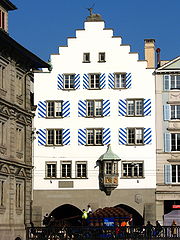
Scots language
Scots is the Germanic language variety spoken in Lowland Scotland and parts of Ulster . It is sometimes called Lowland Scots to distinguish it from Scottish Gaelic, the Celtic language variety spoken in most of the western Highlands and in the Hebrides.Since there are no universally accepted...
corbie: crow) it is likely that this was based on a misreading of lowercase "i" as lowercase "l". Another term sometimes used is craw step.

